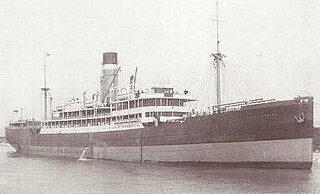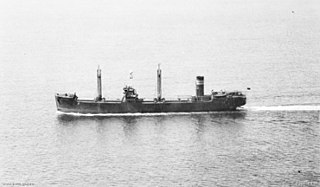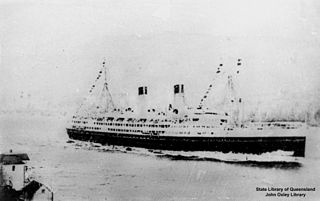
William Denny and Brothers Limited, often referred to simply as Denny, was a Scottish shipbuilding company.

HMS Forfar (F30) was a British ocean liner that was commissioned into the Royal Navy as an armed merchant cruiser in 1939 and sunk by enemy action in 1940. She was launched in Scotland in 1920 as a transatlantic liner for the Canadian Pacific Steamship Company as Montrose. She was one of three sister ships. The others were Montcalm, also launched in 1920, and Montclare, launched in 1921.

SS City of Venice was an intermediate ocean liner that was launched in 1924 in Northern Ireland for Ellerman Lines. In the Second World War she was a troop ship. In 1943 a U-boat sank her in the Mediterranean, killing 22 of the crew and troops aboard.

SS Iron Knight was a bulk carrier that was built in Scotland in 1937 for the Australian Broken Hill Pty, Ltd (BHP) to carry iron ore. A Japanese submarine sank her by torpedo off the coast of New South Wales in 1943, killing 36 of her crew. A wreck that was identified as that of Iron Knight is protected by the Australian federal Underwater Cultural Heritage Act 2018.
SS Patroclus was a UK steam turbine passenger and refrigerated cargo liner launched in 1923. She was the third of five ships to bear the name.
SS Manistee was an Elders & Fyffes Ltd banana boat that was launched in 1920. She was one of a numerous class of similar banana boats built for Elders & Fyffes in the 1920s.
HMS Hilary was a Booth Line passenger steamship that was built in Scotland in 1908 and operated scheduled services between Liverpool and Brazil until 1914. In the First World War she was an armed merchant cruiser (AMC) until a u-boat sank her in the Atlantic Ocean in 1917.
MV Nottingham was a refigerated cargo ship that was built in Scotland in 1949 for the Federal Steam Navigation Co and scrapped in Taiwan in 1971.
MV El Argentino was a refrigerated cargo motor ship that was built in Scotland in 1920 and sunk by a German aircraft in the Atlantic Ocean in 1943.

MV Aorangi was a transpacific ocean liner and refrigerated cargo ship. She was launched in 1924 in Scotland and scrapped in 1953. Her regular route was between Sydney and Vancouver via Auckland, Suva and Honolulu.
SS Iron Chieftain was a bulk carrier that was built in Scotland in 1937 for the Australian Broken Hill Pty, Ltd (BHP) to carry iron ore. A Japanese submarine sank her by torpedo off the coast of New South Wales in 1942, killing 12 of her crew. Her wreck is protected by the Australian federal Underwater Cultural Heritage Act 2018.
SS Clan Macarthur was a British refrigerated cargo steamship. She was built for Cayzer, Irvine and Company's Clan Line Steamers Ltd as one of its Cameron-class steamships. She was launched in Greenock in 1936 and sunk in the Indian Ocean by enemy action in August 1943.

HMS Southern Prince was a motor ship that was built in 1929 as the refrigerated cargo ship Southern Prince. She was commissioned into the Royal Navy in 1940 as a minelayer. She became a headquarters ship and then an accommodation ship in 1944, was a fleet training ship in 1945, and returned to civilian trade in 1946. In 1947 she was sold to Italian owners who had her refitted as a passenger ship and renamed her Anna C. From 1952 she was a cruise ship. She was scrapped in 1972.
SS Glenartney was a cargo steamship that was launched in Scotland in 1911 and sunk by a U-boat in the English Channel in 1918.
MV Seaforth was an Elder Dempster Lines cargo motor ship that traded between Liverpool and West Africa. She was launched in 1938 in Scotland and sunk in 1941 in the North Atlantic.
MV Henry Stanley was a UK cargo motor ship that traded between Liverpool and West Africa. She was launched in 1929 in Scotland and sunk in 1942 in the North Atlantic.
SS Huntingdon was a refrigerated steam cargo liner that was built in Germany in 1920 as Münsterland. The United Kingdom took her as war reparations and sold her to the Federal Steam Navigation Company, who renamed her Huntingdon. She operated between Britain and Australasia until 1941, when an Italian submarine sank her in the Atlantic Ocean.
SS Tregarthen was a cargo steamship that was built in Scotland for the Hain Steam Ship Co in 1936. She was sunk with all hands by a U-boat in 1941 in the Battle of the Atlantic.
SS Hartlebury was a cargo steamship that was launched in Scotland in 1934 for J&C Harrison Ltd. A U-boat sank her in the Barents Sea in 1942 when Hartlebury was a member of the Arctic convoy Convoy PQ 17.
SS Algarve was a Danish cargo steamship that was built in 1921 for DFDS. After Germany invaded Denmark in April 1940 Algarve was transferred to the UK Ministry of War Transport. In 1941 an E-boat sank her with all hands in the North Sea.





